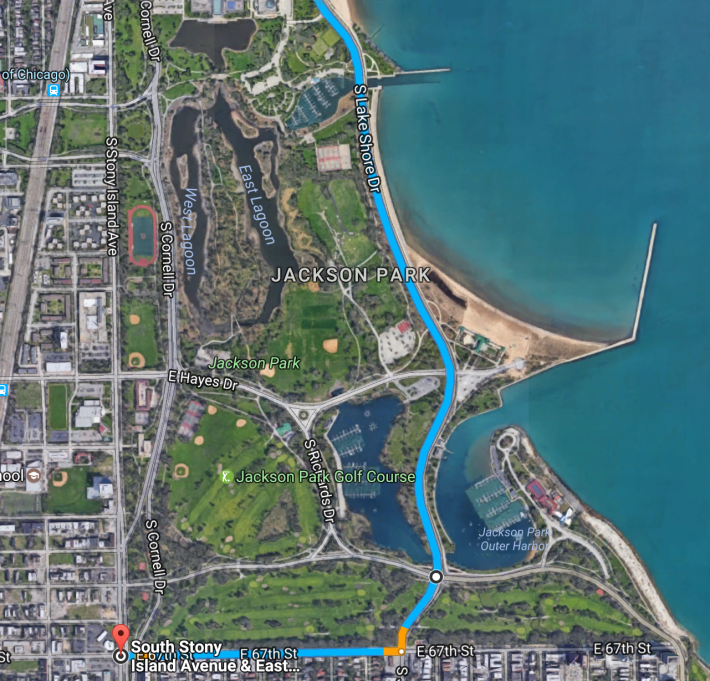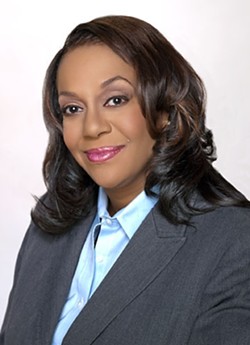It was no surprise to read that 5th Ward alderman Leslie Hairston is opposed to the Obama Foundation’s proposal to pedestrianize streets in Jackson Park near the future presidential library site. After all, she’s shown time and time again that she prioritizes easy driving above all other transportation modes.
More on that in a minute. As reported by DNAinfo, Hairston, whose district includes all of the Frederick Law Olmsted-designed green space, said the proposal to pedestrianize Cornell Drive between 60th and 67th, as well as possibly Marquette Road between Lake Shore and Cornell, “seems like a bad idea.”
Opening up these streets to car-free walking, running, skating, and biking, would also make the park safer and connect the currently fragmented sections of the green space to create a South Side museum campus. It would also unify the two portions of the Jackson Park Golf course, facilitating plans to upgrade it to a tournament quality course.
Hairston told DNA she couldn’t understand how drivers, who currently like to use the park as a shortcut from Lake Shore Drive’s 57th Street exit to the intersection of 67th and Stony Island Avenue, and possibly continue on to the Chicago Skyway, would be able get there without using Cornell.

It’s not that complicated. If we pedestrianize Cornell, a mostly six-lane, highway-like road slicing through one of Chicago’s treasured natural areas, drivers on LSD could instead get off at 57th and go west to Stony Island, or else take the drive all the way to its southern terminus near 67th, and then take that street to Stony.
Hairston argues that the proposal doesn’t account for additional visitors coming to the Obama library and the upgraded golf course. Of course, if decision makers assume that most of those people are going to drive, that could be a self-fulfilling prophesy.
On the other hand, if we follow through with proposals to create rapid transit service on the Metra Electric Line, which has stops a short distance from the library site and golf course, as well as beefing up local bus service, it's likely that many folks will choose to take transit to the park. Making it safer and more convenient to walk and bike through the park by pedestrianizing Cornell and Marquette would reduce the number of car trips as well.
Again, this is far from the first time the alderman has shown a lack of imagination when it comes to alternatives to driving.
In 2009, after the Chicago Park District implemented $1 an hour metered parking at 63rd Street Beach, Hairston opted to use the ward’s discretionary menu money to pay the park district to keep parking free during the summer. In effect, she used public money to feed the meters for people who choose to take their cars to the beach, rather than spending that funding on projects that could benefit all her constituents, including those who don’t own cars.
Hairston made a similar decision in 2013, during the 5th Ward’s participatory budgeting election. Residents proposed spending menu money on pedestrian safety upgrades, new bus shelters and concrete bus pads, and improving the Lakefront Trail and multi-use paths in Jackson Park. However, the alderman decided that these projects should be designated as “service requests” that should be paid for by the Chicago Department of Transportation, the CTA and the Chicago Park District and declared them ineligible for the election. Meanwhile, car-oriented projects stayed on the ballot.
And last year Hairston voiced opposition to the Chicago Department of Transportation’s proposal to convert two lanes of generally eight-lane-wide Stony Island, which has too much capacity for the number of cars it carries, which encourages speeding, to protected bike lanes. "If you take away travel lanes, it will cause congestion," Hairston told me. In addition, Hairston claimed, residents feel that Stony south of 67th is too dangerous for biking. "The traffic speed on most of Stony Island does not lend itself to sharing the road with bikes," she said.
"The idea that the street is too dangerous for bike lanes is something of a cop-out," responded Shawn Conley, chair of the Major Taylor Cycling Club of Chicago, a mostly African-American group. "It's too dangerous to ride on right now," Conley said. "But if they put safe, barrier-protected bike lanes on it, people would bike on it all the time."
Hairston’s ward has good transit access and includes a large chunk of the Lakefront Trail, and it’s an ethnically, economically diverse district where many households don’t own cars. So it’s a shame that, when it comes to transportation access, she often refuses to think outside the metal box.




